
 |
|
|
|
This time Jodorosky makes the magic work ... In his interviews, director Alejandro Jodorowsky asserts that he is not a filmmaker per se but a visionary artist who happens to work in film. The eccentric Chilean made his name with a number of controversial cult releases of the 1970s that might be best described as "anarchic surrealism". Jodorowsky's El Topo and The Holy Mountain were ambitious, scatter-shot epics fueled by the sort of sub-Buñuellian outrage seen in the misanthropic cinema of Fernando Arrabal and Carlos López Moctezuma. Always attempting subjects larger than his filming budget, Jodorowsky emphasized arresting, fertile images over narrative coherence. The director also admits that by starring in his early films he wasted a certain amount of energy on narcissistic aims. With his irreducible simplicity and wicked logic, Luis Buñuel remains untouched by this newer breed of Spanish-speaking rebels, forever working out their anti-Catholic complexes. But Jodorowsky went a step further to energize an audience of hipsters with his hipster embrace of pantheistic spiritualism -- the cult audience for The Holy Mountain considers it a religious experience. 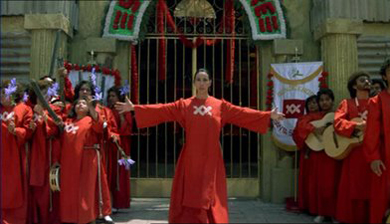
After expending years of effort on a never-realized screen adaptation of the science fiction book Dune, Jodorowsky filmed another epic of symbolic imagery in Mexico for an Italian producer, 1989's Santa Sangre. This time out the director was blessed with a story properly scaled to his production resources. Too old to play the hero, he gave the lead role to his son Axel, a more talented actor with exceptional mime skills. At his most sympathetic, Axel brings to mind a haunted, obsessive Roberto Benigni. Jodorowsky's only slightly over-plotted story is a phantasmagoria suggested by the life of a notorious Mexican serial killer, who eventually reformed and was released from prison to practice law and raise a family. This born-again outrage to the social norm is the kind of anomaly guaranteed to ignite a surrealist's imagination. Debauched American showman Orgo (an obese Guy Stockwell) tours a popular circus through Mexico. He hires a profane performer called The Tattooed Woman (Mexican exotic dancing star Thelma Tixou). Orgo's wife is Concha (Blanca Guerra), a fiery priestess of a cultish religious order worshipping Santa Sangre, a schoolgirl martyred in a rape in which both her arms were cut off. An archbishop declares Concha's church to be heretical, and a developer's bulldozers wipe it out. Concha only survives when her young son Fenix (Adan Jodorowsky) intervenes, but her anger rises again when she finds Orgo making love to his new performer. In a violent confrontation, Orgo winds up dead after cutting off Concha's arms, turning her into the living imitation of her beloved saint. 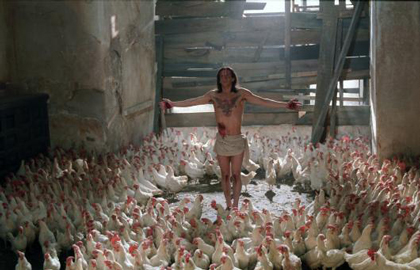
Young Fenix is forced to witness all this and goes insane when The Tattooed Woman leaves with young Alma (Faviola Elenka Tapia), a deaf-mute performer that has captured the boy's heart. Years later, the adult Fenix (Axel Jodorowsky) escapes from an asylum after being beckoned by his armless mother. He learns to perform with her, providing the arms for her surreal stage act. He is emotionally dominated by Concha, who controls his arms as if they were hers. The perverted result of this is that Concha forces Fenix to slaughter any woman who arouses his interest. The passive Axel spends his off hours (when he's not helping Concha eat, perform or knit) trying to perfect an invisibility formula, like the mad doctor from a horror movie. Little does he know that The Tattooed Woman is now a prostitute and Alma her helpless assistant. The innocent Alma escapes from a drunken client and sees one of Concha and Axel's theatrical posters, and becomes determined to find Fenix. Santa Sangre invents an entire symbolic cosmos around its seeker of redemption. Cameraman Daniele Nannuzzi and production designer Alejandro Luna dress Jodorowsky's ideas in one attractive, startling image after another. In this movie even the circus clowns seem like a fresh idea, squirting fake tears in a garish funeral procession towing the enormous coffin of a dead elephant. Nannuzzi and Luna pull off an arresting stage show, with Axel miming Concha's arms as Mariachis play. The Temple of Santa Sangre is a shrine in which red-robed women are baptized in a pool of water tinted blood red. 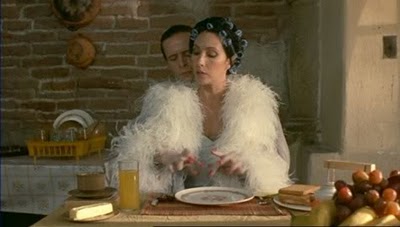
The Tattooed Woman is adorned with weird paintings the entire length of her body, while the pixie-ish Alma (played as an adult by a real deaf mute, Sabrina Dennison) strikes enchanting poses in a ballet tutu, white face paint and a Mexican headdress. Jodorowsky paid for local protection to film scenes in seedy locales frequented by prostitutes and pimps, which makes for some disturbing scenes when one procurer (played by Teo Jodorowsky) entices Fenix's fellow asylum children to use cocaine and be entertained by an enormous prostitute. The director uses real mentally challenged children for these scenes, which makes for the film's most uncomfortable moments. Although extremely bloody, the film's violence is filmed stylishly and is less objectionable than the ugly excesses of El Topo: no animals are slaughtered for on-camera thrills. 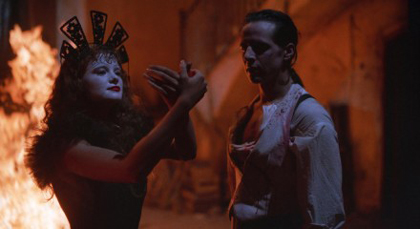
Santa Sangre builds a fantastic legend to explain the crimes of a serial killer. Luis Buñuel attacked this problem in movies like El and The Criminal Life of Archibaldo de la Cruz, but Jodorowsky goes farther by asking us to sympathize with his mad murderer. The adult Fenix mixes chemicals while imitating the dress and actions of Claude Rains in The Invisible Man, seen behind him on the television. But the director's twisted personal vision also intersects with Tod Browning's Freaks (the bizarre, loving circus background), Browning's The Unknown (the armless amputee performer), and Peter Lorre's version of The Hands of Orlac, Mad Love. This last connection is the most interesting, as the domineering Concha effects a mental control over her son, using his arms as if they were her own. Axel Jodorowsky makes these scenes extremely effective, as he pantomimes feminine hand movements and gestures while wearing long red fingernails. This surreal spectacle achieves an operatic quality reminiscent of The Tales of Hoffman; and the film's final revelation conjures a symbolist retelling of Psycho. Santa Sangre is often described as Alejandro Jodorowsky's most accessible movie, and it's also his most entertaining. The non-sequitur craziness is still apparent, as the director cannot resist adding queasy details for their own sake. A man is shown peeling a fake ear from his head, revealing that his real ear has been sliced away. The man just presented himself to Jodorowsky during the filming. But the film is adept in its method and consistent in its visuals. Santa Sangre is a superior film of its kind. 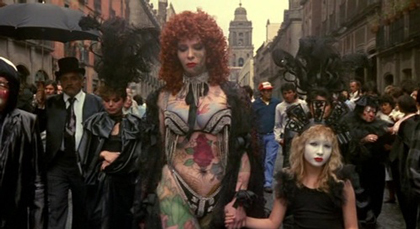
Severin's Blu-ray (and DVD) of Santa Sangre is probably the adventurous label's most accomplished release to date. The sharp HD transfer is a thing of beauty, with exceptionally bright colors. Severin includes English and Italian audio tracks in stereo and a monaural Spanish track, all of high quality. Severin's extras go to extremes to document the making of the film. An exhaustive feature-length HD docu has a candid interview with director Jodorowsky and includes input from two of his sons and actors Blanca Guerra, Thelma Tixou, Faviola Elenka Tapia and Sabrina Dennison, who communicates in sign language. Composer Simon Boswell and designer Alejandro Luna also participate; Boswell interviews his director for another extra. The extras just keep coming. Jodorowsky shares an audio commentary with writer Alan Jones and adds his comments to a selection of deleted scenes. A 1990 British TV show on the director is present, along with an incisive biographical piece on Goyo Cárdenas, the mad killer who inspired the film. Two more Jodorowky interviews are included before the extras turn to short films and music videos by Simon Boswell and Adan Jodorowski, and a pair of original trailers.
On a scale of Excellent, Good, Fair, and Poor,
Santa Sangre Blu-ray rates:
Reviews on the Savant main site have additional credits information and are often updated and annotated with reader input and graphics. Also, don't forget the 2010 Savant Wish List. T'was Ever Thus.
Review Staff | About DVD Talk | Newsletter Subscribe | Join DVD Talk Forum |
| ||||||||||||||||||